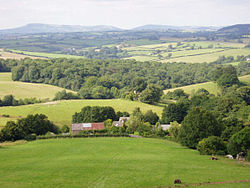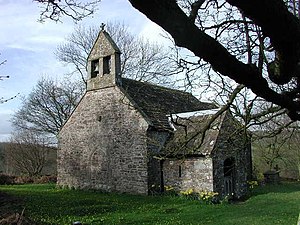Kilgwrrwg: Difference between revisions
Created page with "{{Infobox town |name=Kilgwrrwg |county=Monmouthshire |picture=Kilgwrrwg.jpg |picture caption=Rolling countryside at Kilgwrrwg, looking northwards |os grid ref=ST462985 |latitu..." |
No edit summary |
||
| Line 10: | Line 10: | ||
|postcode=NP16 | |postcode=NP16 | ||
|dialling code=01291 | |dialling code=01291 | ||
|population= | |population=102 | ||
|census year= | |census year= | ||
|LG district=Monmouthshire | |LG district=Monmouthshire | ||
| Line 26: | Line 26: | ||
The church is surrounded by a partly curved churchyard, suggesting a Celtic foundation, and has been described as "the most perfect example of an early Christian site".<ref name=zaluckyj>{{cite book| last1 = Zaluckyj | first1 = Sarah| first2 = John | last2 = Zaluckyj| title = The Celtic Christian Sites of the Central and Southern Marches | location = Hereford | publisher = Logaston Press | year= 2006 | pages = 333–334| isbn = 1-904396-57-7 }}</ref> It is thought to have been referred to indirectly in a charter of about 722, cited in the ''Book of Llandaff''.<ref name=zaluckyj/> According to local legend, the location of the church was determined when a pair of heifers, yoked together, were left to wander, and came to rest on a small mound, signifying that the place was divinely ordained for a church to be built there.<ref name="Aslet2011"/> | The church is surrounded by a partly curved churchyard, suggesting a Celtic foundation, and has been described as "the most perfect example of an early Christian site".<ref name=zaluckyj>{{cite book| last1 = Zaluckyj | first1 = Sarah| first2 = John | last2 = Zaluckyj| title = The Celtic Christian Sites of the Central and Southern Marches | location = Hereford | publisher = Logaston Press | year= 2006 | pages = 333–334| isbn = 1-904396-57-7 }}</ref> It is thought to have been referred to indirectly in a charter of about 722, cited in the ''Book of Llandaff''.<ref name=zaluckyj/> According to local legend, the location of the church was determined when a pair of heifers, yoked together, were left to wander, and came to rest on a small mound, signifying that the place was divinely ordained for a church to be built there.<ref name="Aslet2011"/> | ||
The churchyard contains a plain short-armed stone cross, impossible to date accurately but thought by some to be pre-Norman<ref name=zaluckyj/> and described by others as | The churchyard contains a plain short-armed stone cross, impossible to date accurately but thought by some to be pre-Norman<ref name=zaluckyj/> and described by others as mediæval.<ref name="newman">{{Cite book | last=Newman | first=John | year=2000 | title=The Buildings of Wales: Gwent/Monmouthshire | publisher=Penguin Books | page=262 | isbn=0-14-071053-1}}</ref> There is also a stone carving of a head, again thought to be pre-Norman and sometimes described as a female fertility figure,<ref name="Aslet2011"/> placed in the wall.<ref name=zaluckyj/> The church is built of Old Red Sandstone. It contains some Early English architectural features, including the walls and a window in the nave.<ref name="newman"/> | ||
By the early nineteenth century, the building was partly ruined and used as a livestock shelter.<ref name="Aslet2011"/> According to the local schoolteacher and philanthropist James Davies of [[Devauden]],<ref name=great>[http://books.google.co.uk/books?id=9VQBAAAAQAAJ&pg=PA103&dq=Kilgwrrwg&hl=en&sa=X&ei=M-WXT933C5GXhQeNgeX3BQ&ved=0CF0Q6AEwCA#v=onepage&q=Kilgwrrwg&f=false ''The great and good; illustrated in six sketches'', Anon., 1855]</ref><blockquote>"...the little church was in decay; rain and snow penetrated through the roof into the body of the building, and a neighbouring farmer folded his sheep within the walls of God's house. On twelve Sundays in the year, and on those only, was public worship performed in that church; and on those occasions the accumulated filth of sheep and cattle was shovelled out the day before."</blockquote> Davies encouraged the local residents to pay for the re-roofing of the church.<ref name=great/> It was further restored by John Prichard around 1871, and a porch, bellcote and windows were added at that time.<ref name="newman"/><ref>{{cite web|url=http://www.churchcrawler.pwp.blueyonder.co.uk/churchcrawler/gwent.htm|title=Some East Gwent Churches| publisher=Churchcrawler|accessdate=17 April 2012}}</ref> Further restoration work was carried out in 1989/90.<ref name="newman"/> It is a Grade II* listed building.<ref>{{cite web|url=http://britishlistedbuildings.co.uk/wa-2025-church-of-the-holy-cross-devauden|title=Church of the Holy Cross, Devauden|publisher=British Listed Buildings|accessdate=17 April 2012}}</ref> | By the early nineteenth century, the building was partly ruined and used as a livestock shelter.<ref name="Aslet2011"/> According to the local schoolteacher and philanthropist James Davies of [[Devauden]],<ref name=great>[http://books.google.co.uk/books?id=9VQBAAAAQAAJ&pg=PA103&dq=Kilgwrrwg&hl=en&sa=X&ei=M-WXT933C5GXhQeNgeX3BQ&ved=0CF0Q6AEwCA#v=onepage&q=Kilgwrrwg&f=false ''The great and good; illustrated in six sketches'', Anon., 1855]</ref><blockquote>"...the little church was in decay; rain and snow penetrated through the roof into the body of the building, and a neighbouring farmer folded his sheep within the walls of God's house. On twelve Sundays in the year, and on those only, was public worship performed in that church; and on those occasions the accumulated filth of sheep and cattle was shovelled out the day before."</blockquote> Davies encouraged the local residents to pay for the re-roofing of the church.<ref name=great/> It was further restored by John Prichard around 1871, and a porch, bellcote and windows were added at that time.<ref name="newman"/><ref>{{cite web|url=http://www.churchcrawler.pwp.blueyonder.co.uk/churchcrawler/gwent.htm|title=Some East Gwent Churches| publisher=Churchcrawler|accessdate=17 April 2012}}</ref> Further restoration work was carried out in 1989/90.<ref name="newman"/> It is a Grade II* listed building.<ref>{{cite web|url=http://britishlistedbuildings.co.uk/wa-2025-church-of-the-holy-cross-devauden|title=Church of the Holy Cross, Devauden|publisher=British Listed Buildings|accessdate=17 April 2012}}</ref> | ||
==Other buildings== | ==Other buildings== | ||
Kilgwrrwg House is a hall house of the early sixteenth century, with a massive chimney stack of later date. The house is a listed building.<ref>http://www.coflein.gov.uk/en/site/45008/details/KILGWRRWG+HOUSE%3BLOWER+KILGWRRWG/</ref> | Kilgwrrwg House is a hall house of the early sixteenth century, with a massive chimney stack of later date. The house is a listed building.<ref>http://www.coflein.gov.uk/en/site/45008/details/KILGWRRWG+HOUSE%3BLOWER+KILGWRRWG/</ref> | ||
Latest revision as of 20:38, 7 January 2016
| Kilgwrrwg | |
| Monmouthshire | |
|---|---|
 Rolling countryside at Kilgwrrwg, looking northwards | |
| Location | |
| Grid reference: | ST462985 |
| Location: | 51°40’49"N, 2°46’8"W |
| Data | |
| Population: | 102 |
| Post town: | Chepstow |
| Postcode: | NP16 |
| Dialling code: | 01291 |
| Local Government | |
| Council: | Monmouthshire |
| Parliamentary constituency: |
Monmouth |
Kilgwrrwg is a rural parish in Monmouthshire, seven miles north-west of Chepstow and seven miles south-east of Usk below the Trellech ridge.[1] It forms part of the Raglan Hundred.
History
The Welsh-language placename element cil means a corner, or retreat, usually in a religious context, and the settlement name is suggestive of its Celtic Christian origins.[2] In 1811 the parish had a population of 133, and in 1831 it had a population of 113 and 26 houses.[3][4][5]
Church of the Holy Cross

The Church of the Holy Cross at Kilgwrrwg is one of the most remote parish churches in the UK still in regular use.[6] It can only be reached by crossing two fields and a stream from the nearest house.
The church is surrounded by a partly curved churchyard, suggesting a Celtic foundation, and has been described as "the most perfect example of an early Christian site".[2] It is thought to have been referred to indirectly in a charter of about 722, cited in the Book of Llandaff.[2] According to local legend, the location of the church was determined when a pair of heifers, yoked together, were left to wander, and came to rest on a small mound, signifying that the place was divinely ordained for a church to be built there.[6]
The churchyard contains a plain short-armed stone cross, impossible to date accurately but thought by some to be pre-Norman[2] and described by others as mediæval.[7] There is also a stone carving of a head, again thought to be pre-Norman and sometimes described as a female fertility figure,[6] placed in the wall.[2] The church is built of Old Red Sandstone. It contains some Early English architectural features, including the walls and a window in the nave.[7]
By the early nineteenth century, the building was partly ruined and used as a livestock shelter.[6] According to the local schoolteacher and philanthropist James Davies of Devauden,[8]
"...the little church was in decay; rain and snow penetrated through the roof into the body of the building, and a neighbouring farmer folded his sheep within the walls of God's house. On twelve Sundays in the year, and on those only, was public worship performed in that church; and on those occasions the accumulated filth of sheep and cattle was shovelled out the day before."
Davies encouraged the local residents to pay for the re-roofing of the church.[8] It was further restored by John Prichard around 1871, and a porch, bellcote and windows were added at that time.[7][9] Further restoration work was carried out in 1989/90.[7] It is a Grade II* listed building.[10]
Other buildings
Kilgwrrwg House is a hall house of the early sixteenth century, with a massive chimney stack of later date. The house is a listed building.[11]
The small hamlet of Kilgwrrwg Common is located about one mile from the church. Great Kilgwrrwg Farm is also located in the vicinity.[12]
References
- ↑ Botanical Society of the British Isles (1902). Report for 1879-1947. p. 357. http://books.google.com/books?id=NNhCAAAAYAAJ. Retrieved 17 April 2012.
- ↑ 2.0 2.1 2.2 2.3 2.4 Zaluckyj, Sarah; Zaluckyj, John (2006). The Celtic Christian Sites of the Central and Southern Marches. Hereford: Logaston Press. pp. 333–334. ISBN 1-904396-57-7.
- ↑ Philipps, Thomas (1852). The life of James Davies, a village schoolmaster. Parker and son. p. 30. http://books.google.com/books?id=ooSmyOoz10kC&pg=PA30. Retrieved 17 April 2012.
- ↑ Lewis, Samuel (1831). A Topographical Dictionary of England. Lewis. p. 504. http://books.google.com/books?id=MMc_AAAAcAAJ&pg=PA504. Retrieved 17 April 2012.
- ↑ Moule, Thomas (1837). The English Counties Delineated. Virtue. p. 58. http://books.google.com/books?id=la0_AAAAcAAJ&pg=PA58. Retrieved 17 April 2012.
- ↑ 6.0 6.1 6.2 6.3 Aslet, Clive (15 August 2011). Villages of Britain: The Five Hundred Villages that Made the Countryside. Bloomsbury. p. 480. ISBN 978-1-4088-1799-5. http://books.google.com/books?id=EevCB9br6F4C&pg=PA480. Retrieved 17 April 2012.
- ↑ 7.0 7.1 7.2 7.3 Newman, John (2000). The Buildings of Wales: Gwent/Monmouthshire. Penguin Books. p. 262. ISBN 0-14-071053-1.
- ↑ 8.0 8.1 The great and good; illustrated in six sketches, Anon., 1855
- ↑ "Some East Gwent Churches". Churchcrawler. http://www.churchcrawler.pwp.blueyonder.co.uk/churchcrawler/gwent.htm. Retrieved 17 April 2012.
- ↑ "Church of the Holy Cross, Devauden". British Listed Buildings. http://britishlistedbuildings.co.uk/wa-2025-church-of-the-holy-cross-devauden. Retrieved 17 April 2012.
- ↑ http://www.coflein.gov.uk/en/site/45008/details/KILGWRRWG+HOUSE%3BLOWER+KILGWRRWG/
- ↑ The Municipal year book and public services directory. Municipal Publications Ltd.. 1972. p. 1504. http://books.google.com/books?id=FEE5AQAAIAAJ. Retrieved 17 April 2012.